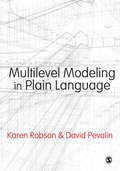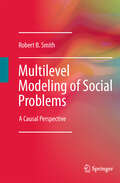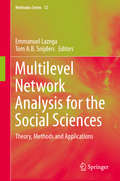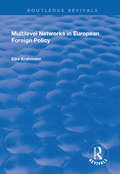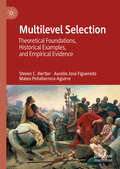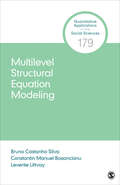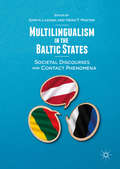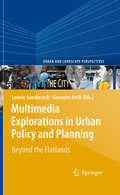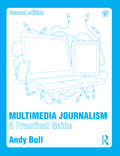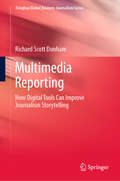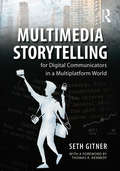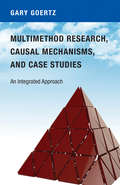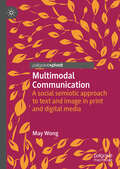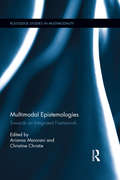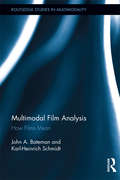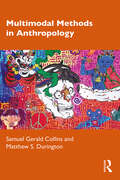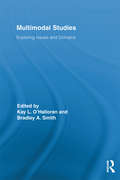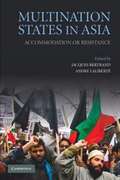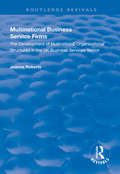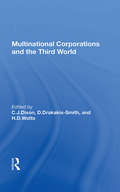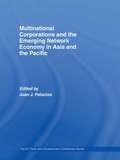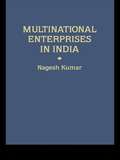- Table View
- List View
Multilevel Modeling in Plain Language
by David Pevalin Karen RobsonHave you been told you need to do multilevel modeling, but you can′t get past the forest of equations? Do you need the techniques explained with words and practical examples so they make sense? Help is here! This book unpacks these statistical techniques in easy-to-understand language with fully annotated examples using the statistical software Stata. The techniques are explained without reliance on equations and algebra so that new users will understand when to use these approaches and how they are really just special applications of ordinary regression. Using real life data, the authors show you how to model random intercept models and random coefficient models for cross-sectional data in a way that makes sense and can be retained and repeated. This book is the perfect answer for anyone who needs a clear, accessible introduction to multilevel modeling.
Multilevel Modeling of Social Problems
by Robert B. SmithUniquely focusing on intersections of social problems, multilevel statistical modeling, and causality; the substantively and methodologically integrated chapters of this book clarify basic strategies for developing and testing multilevel linear models (MLMs), and drawing casual inferences from such models. These models are also referred to as hierarchical linear models (HLMs) or mixed models. The statistical modeling of multilevel data structures enables researchers to combine contextual and longitudinal analyses appropriately. But researchers working on social problems seldom apply these methods, even though the topics they are studying and the empirical data call for their use. By applying multilevel modeling to hierarchical data structures, this book illustrates how the use of these methods can facilitate social problems research and the formulation of social policies. It gives the reader access to working data sets, computer code, and analytic techniques, while at the same time carefully discussing issues of causality in such models. This book innovatively: *Develops procedures for studying social, economic, and human development. * Uses typologies to group (i.e., classify or nest) the level of random macro-level factors. * Estimates models with Poisson, binomial, and Gaussian end points using SAS's generalized linear mixed models (GLIMMIX) procedure. * Selects appropriate covariance structures for generalized linear mixed models. * Applies difference-in-differences study designs in the multilevel modeling of intervention studies. *Calculates propensity scores by applying Firth logistic regression to Goldberger-corrected data. * Uses the Kenward-Rogers correction in mixed models of repeated measures. * Explicates differences between associational and causal analysis of multilevel models. * Consolidates research findings via meta-analysis and methodological critique. *Develops criteria for assessing a study's validity and zone of causality. Because of its social problems focus, clarity of exposition, and use of state-of-the-art procedures; policy researchers, methodologists, and applied statisticians in the social sciences (specifically, sociology, social psychology, political science, education, and public health) will find this book of great interest. It can be used as a primary text in courses on multilevel modeling or as a primer for more advanced texts.
Multilevel Network Analysis for the Social Sciences
by Emmanuel Lazega Tom A.B. SnijdersThis volume provides new insights into the functioning of organizational, managerial and market societies. Multilevel analysis and social network analysis are described and the authors show how they can be combined in developing the theory, methods and empirical applications of the social sciences. This book maps out the development of multilevel reasoning and shows how it can explain behavior, through two different ways of contextualizing it. First, by identifying levels of influence on behavior and different aggregations of actors and behavior, and complex interactions between context and behavior. Second, by identifying different levels as truly different systems of agency: such levels of agency can be examined separately and jointly since the link between them is affiliation of members of one level to collective actors at the superior level. It is by combining these approaches that this work offers new insights. New case studies and datasets that explore new avenues of theorizing and new applications of methodology are presented. This book will be useful as a reference work for all social scientists, economists and historians who use network analyses and multilevel statistical analyses. Philosophers interested in the philosophy of science or epistemology will also find this book valuable.
Multilevel Networks in European Foreign Policy (Routledge Revivals Ser.)
by Elke KrahmannThis title was first published in 2003. Combining a critique of existing multilevel approaches with the development of a new theory and a broad range of case studies, the author of this text aims to provide new insights into contemporary foreign policy decision-making which should be of particular interest to students and scholars of European foreign and security policy and international relations theory.
Multilevel Selection: Theoretical Foundations, Historical Examples, and Empirical Evidence
by Steven C. Hertler Aurelio José Figueredo Mateo Peñaherrera-AguirreThis book embeds a novel evolutionary analysis of human group selection within a comprehensive overview of multilevel selection theory, a theory wherein evolution proceeds at the level of individual organisms and collectives, such as human families, tribes, states, and empires. Where previous works on the topic have variously supported multilevel selection with logic, theory, experimental data, or via review of the zoological literature; in this book the authors uniquely establish the validity of human group selection as a historical evolutionary process within a multilevel selection framework.Select portions of the historical record are examined from a multilevel selectionist perspective, such that clashing civilizations, decline and fall, law, custom, war, genocide, ostracism, banishment, and the like are viewed with the end of understanding their implications for internal cohesion, external defense, and population demography. In doing so, its authors advance the potential for further interdisciplinary study in fostering, for instance, the convergence of history and biology. This work will provide fresh insights not only for evolutionists but also for researchers working across the social sciences and humanities.
Multilevel Structural Equation Modeling (Quantitative Applications in the Social Sciences #179)
by Levente Littvay Bruno Castanho Silva Constantin Manuel BosancianuMultilevel Structural Equation Modeling serves as a minimally technical overview of multilevel structural equation modeling (MSEM) for applied researchers and advanced graduate students in the social sciences. As the first book of its kind, this title is an accessible, hands-on introduction for beginners of the topic. The authors predict a growth in this area, fueled by both data availability and also the availability of new and improved software to run these models. The applied approach, combined with a graphical presentation style and minimal reliance on complex matrix algebra guarantee that this volume will be useful to social science graduate students wanting to utilize such models.
Multilevel Structural Equation Modeling (Quantitative Applications in the Social Sciences #179)
by Levente Littvay Bruno Castanho Silva Constantin Manuel BosancianuMultilevel Structural Equation Modeling serves as a minimally technical overview of multilevel structural equation modeling (MSEM) for applied researchers and advanced graduate students in the social sciences. As the first book of its kind, this title is an accessible, hands-on introduction for beginners of the topic. The authors predict a growth in this area, fueled by both data availability and also the availability of new and improved software to run these models. The applied approach, combined with a graphical presentation style and minimal reliance on complex matrix algebra guarantee that this volume will be useful to social science graduate students wanting to utilize such models.
Multilingualism in Education in Nepal: Ideology and Identity (Nepal and Himalayan Studies)
by Laxman GhimireThis book explores the development of multilingual policy in education in Nepal in sociopolitical and historical contexts and examines the frameworks of language use in schools. It investigates the dynamics and factors that influence the process of construction and appropriation of the policy of multilingualism in education. The book surveys the language situation in schools and discusses how it is impacted by local language positions, societal power relations, ideological and identity contestations, and the attitude, language behaviour and resistance of key actors. It highlights the role of pedagogy, linguistics and politics that govern the policy of multilingual education. The author assesses the prospects of a multilingual approach to learning via teacher preparation, curriculum and learning material development, coordination of actors and institutions, and resources available in schools. The book presents Nepal’s linguistic background while discussing how multilingualism in education recognises local languages to improve the quality of learning in classrooms in ethnolinguistic communities. Evaluating the use of local languages in classrooms, it explores monolingual, multilingual and language maintenance frameworks of multilingualism in education. This book will be of interest to teachers, students, and researchers of education and educational studies, linguistics, sociology of education, school education, language studies, sociolinguistics, language policy and planning, public administration, ethnolinguistics, and sociology of language. It will also be useful to educationists, policymakers, linguists, sociolinguists and those working in related areas.
Multilingualism in the Baltic States: Societal Discourses And Contact Phenomena
by Heiko F. Marten Sanita LazdiņaThis edited collection provides an overview of linguistic diversity, societal discourses and interaction between majorities and minorities in the Baltic States. It presents a wide range of methods and research paradigms including folk linguistics, discourse analysis, narrative analyses, code alternation, ethnographic observations, language learning motivation, languages in education and language acquisition. Grouped thematically, its chapters examine regional varieties and minority languages (Latgalian, Võro, urban dialects in Lithuania, Polish in Lithuania); the integration of the Russian language and its speakers; and the role of international languages like English in Baltic societies. The editors’ introductory and concluding chapters provide a comparative perspective that situates these issues within the particular history of the region and broader debates on language and nationalism at a time of both increased globalization and ethno-regionalism. This book will appeal in particular to students and scholars of multilingualism, sociolinguistics, language discourses and language policy, and provide a valuable resource for researchers focusing on Baltic States, Northern Europe and the post-Soviet world in the related fields of history, political science, sociology and anthropology.
Multimedia Explorations in Urban Policy and Planning
by Giovanni Attili Leonie SandercockThe book is a collection of essays exploring the potential of multimedia to enrich and transform the planning field. By multimedia the authors refer to a broad range of new information and communication technologies (from film and video to digital ethnography and the internet), which are opening up new possibilities in planning practices, processes, pedagogy and research. The authors document the ways in which these ICTs can expand the language of planning and the creativity of planners; can evoke the lived experience (the spirit, memories, desires) of our 21st century mongrel cities by engaging with stories and storytelling; and can democratise planning practices. The text is epistemologically radical, in presenting an argument for the importance of "multiple languages" (ways of knowing) in the planning field, and making the connection between this epistemology and the almost infinite potential of Multimedia to provide varied tools to accomplish this transformation, displacing the supremacy of the rational, linear and hierarchical with more open, playful and imaginative approaches. Each of the authors brings practical experience with different forms of Multimedia use and reflects on the different potentialities offered by Multimedia for critical intervention in urban and regional issues, and the power dynamics embedded in such interventions.
Multimedia Journalism: A Practical Guide
by Andy BullMultimedia Journalism: A Practical Guide, Second edition builds on the first edition’s expert guidance on working across multiple media platforms, and continues to explore getting started, building proficiency and developing professional standards in multimedia journalism. The second edition features new chapters including: getting started with social media live reporting building proficiency with Wordpress building apps for smartphones and tablets building a personal brand and developing a specialism long-form video journalism, audio and video news bulletins and magazine programmes. The new edition also includes an extensive range of new and updated materials essential for all aspects multimedia journalism today. New areas explored include editing video and slideshows for mobile and tablet devices, the advanced use of mobile devices for reporting, location-specific content creation and delivery, the use of video and audio slideshows, and live blogging. Other updates include more material on photojournalism as a storytelling technique, using and transferring digital images and sound, the use of Google Analytics, and practical guides to storytelling through infographics, timelines, interactive graphics and maps. The book fully engages with multimedia journalism in relation to range of social media and web publishing platforms, including Wordpress, Blogger, Tumblr, Twitter, Facebook, Google+, YouTube, Instagram, Pinterest, SoundCloud, AudioBoom and iTunes. The book is also be supported by fully updated online masterclasses at www.multimedia-journalism.co.uk.
Multimedia Reporting: How Digital Tools Can Improve Journalism Storytelling (Tsinghua Global Business Journalism Series)
by Richard Scott DunhamThis is the first book to apply multimedia tools to economic and business storytelling. By examining the journalism essentials as well as the advanced multimedia skills, it helps readers use the latest technological tools to integrate multimedia elements into traditional news coverage. It also explains how to tell stories solely through multimedia elements. The new language of online journalism includes writing for digital platforms, writing blogs and writing for social media and involves a wide range of multimedia skills, like video, audio, photography, graphics, data visualization and animation. Multimedia journalism allows a two-way communication with the audience that was not possible in traditional “legacy” media, and this textbook is replete with links to useful tutorials, examples of award-winning multimedia stories, and advanced digital resources, offering journalists a road map to the brave new world of digital reporting and editing.
Multimedia Stardom in Hong Kong: Image, Performance and Identity (Media, Culture and Social Change in Asia)
by Leung Wing-FaiThis book details original research into the practices and discourse of multimedia stardom alongside changing social and cultural landscapes in Hong Kong since 1980. It examines the cultural and sociological significance of stardom in the region, and the conditions which gave rise to such famous stars as Jackie Chan. This book elaborates the distinction between multimedia stardom and celebrity, asserting that in Hong Kong stardom has been central in the production and consumption of local media, while demonstrating the importance of multimedia stardom as part of the ‘cultural Chinese’ mediascape and transnational popular culture from both historical and contemporary contexts.
Multimedia Storytelling for Digital Communicators in a Multiplatform World
by Seth GitnerMultimedia Storytelling for Digital Communicators in a Multiplatform World is a unique guide for all students who need to master visual communication through multiple media and platforms. Every communication field now requires students to be fluent in visual storytelling skill sets, and as the present-day media adapt to a multiplatform world (with ever-increasing delivery systems from desktops to cell phones), students specializing in different forms of communication are discovering the power of merging new multimedia technology with very old and deep-rooted storytelling concepts. Award-winning journalist and multimedia professor Seth Gitner provides students with the tools for successfully realizing this merger, from understanding conflict, characters, and plot development to conducting successful interviews, editing video in post-production, and even sourcing royalty-free music and sound effects. Incorporating how-to’s on everything from website and social media optimization to screenwriting, Multimedia Storytelling aims to be a resource for any student who needs to think and create visually, in fields across broadcast and digital journalism, film, photography, advertising, and public relations. The book also includes a range of supplemental material, including wide-ranging skills exercises for each chapter, interviews with seasoned professionals, key terms, and review questions.
Multimethod Research, Causal Mechanisms, and Case Studies: An Integrated Approach
by Gary GoertzAn innovative and accessible textbook on multimethod and case-study researchMultimethod research has become indispensable to doing social science, and is essential to anyone who conducts large-scale research projects in political science, sociology, education, comparative law, or business. This authoritative and accessible book offers the first truly comprehensive approach to multimethod and case-study research, and is particularly aimed at students of qualitative methods in the social sciences.Walking step-by-step through these cutting-edge tools and techniques, Gary Goertz introduces a new integrated approach that unites three corners of a powerful research triad—causal mechanisms, cross-case causal inference, and within-case causal inference. He explains how the investigation of causal mechanisms and the making of within-case causal inference are the central goals of multimethod and case study research, and provides a logic for connecting case studies and causal mechanism analysis with cross-case analysis, whether they are statistical analyses, experiments, or QCA. In addition, Goertz analyzes how one can generalize using case studies, as well as systematically test game-theoretic and other models using multiple case studies.Provides a fully integrated approach to multimethod and case-study researchAn essential resource for students and researchers in political science, sociology, education, law, and businessCovers constraint causal mechanism, game theory and case studies, QCA, and the use of case studies to systematically test and generalize theoriesAn ideal textbook for a first-year graduate course in methods or research design
Multimodal Communication: A social semiotic approach to text and image in print and digital media
by May WongThis book draws on visual data, ranging from advertisements to postage stamps to digital personal photography, to offer a complex interpretation of the different social functions realised by these texts as semiotic artefacts. Framed within the media environment of the city of Hong Kong, the study demonstrates the importance of social context to meaning making and social semiotic multimodal analysis. This book will be of interest to readers in the arts, humanities and social sciences, particularly within the fields of semiotics, visual studies, design studies, media and cultural studies, anthropology and sociology.
Multimodal Epistemologies: Towards an Integrated Framework (Routledge Studies in Multimodality)
by Arianna Maiorani Christine ChristieThis volume develops a new multimodal semiotic approach to the study of communication, examining how multimodal discourse is construed transmedially and interculturally and how new technologies and cultural stances inform communicative contexts across the world. It contributes to current theoretical debates in the disciplines of semiotics, linguistics, multimodality, and pragmatics, as well as those aspects of pedagogy and film studies that engage with the notions of text and narrative by addressing questions such as: How do we study multimedia communication? How do we incorporate the impact of new media technologies into the study of Linguistics and Semiotics? How do we construe culture in modern communication? How useful are the current multidisciplinary approaches to multimodal communication? Through the analysis of specific case studies that are developed within diverse academic disciplines and which draw on a range of theoretical frameworks, the goal of this book is to provide a basis for an overarching framework that can be applied by scholars and students with different academic and cultural backgrounds.
Multimodal Film Analysis: How Films Mean (Routledge Studies in Multimodality)
by John Bateman Karl-Heinrich SchmidtThis book presents a new basis for the empirical analysis of film. Starting from an established body of work in film theory, the authors show how a close incorporation of the current state of the art in multimodal theory—including accounts of the syntagmatic and paradigmatic axes of organisation, discourse semantics and advanced ‘layout structure’—builds a methodology by which concrete details of film sequences drive mechanisms for constructing filmic discourse structures. The book introduces the necessary background, the open questions raised, and the method by which analysis can proceed step-by-step. Extensive examples are given from a broad range of films. With this new analytic tool set, the reader will approach the study of film organisation with new levels of detail and probe more deeply into the fundamental question of the discipline: just how is it that films reliably communicate meaning?
Multimodal Methods in Anthropology
by Samuel Gerald Collins Matthew S. DuringtonMultimodal Methods in Anthropology develops several goals simultaneously. First, it is an introduction to the ways that multimodality might work for students and practitioners of anthropology, using multiple examples from the authors’ research and from the field. Second, the book carefully examines the ethics of a multimodal project, including the ways in which multimodality challenges and reproduces “digital divides.” Finally, the book is a theoretical introduction that repositions the history of anthropology along axes of multimodality and reframes many of the essential questions in anthropology alongside collaboration and access. Each chapter introduces new methods and techniques, frames the ethical considerations, and contextualizes the method in the work of other anthropologists. Multimodal Methods in Anthropology takes both students and practitioners through historical and contemporary sites of multimodality and introduces the methodological and theoretical challenges of multimodal anthropology in a digital world. Like multimodality itself, readers will come away with new ideas and new perspectives on established ideas, together with the tools to make them part of their practice. It is an ideal text for a variety of methods-based courses in anthropology and qualitative research at both the undergraduate and the graduate level.
Multimodal Studies: Exploring Issues and Domains (Routledge Studies in Multimodality)
by Kay L. O’Halloran Bradley A. Smith New YorkThe phenomenon of multimodality has, as Jewitt observes, generated interest "across many disciplines...against the backdrop of considerable social change." Contemporary societies are grappling with the social implications of the rapid increase in sophistication and range of multimodal practices, particularly within interactive digital media, so that the study of multimodality also becomes essential within an increasing range of practical domains. As a result of this increasing interest in multimodality, scholars, teachers and practitioners are on the one hand uncovering many different issues arising from its study, such as those of theory and methodology, while also exploring multimodality within an increasing range of domains. Such an increase and range of interest in multimodality heralds the emergence of a distinct multimodal studies field: as both the mapping of a domain of enquiry, and as the site of the development of theories, descriptions and methodologies specific to and adapted for the study of multimodality. The present volume presents a range of works by an impressive international roster of contributors who both explore issues arising from the study of multimodality and explore the scope of this emerging field within specific domains of multimodal phenomena. Contributors aim to show that each individual work and works in general within multimodal studies represent a dialectic or complementarity between the exploration of issues of general significance to multimodal studies and the exploration of specific domains of multimodality; while characterizing specific works as tending to some degree towards one or other of these main areas of focus. Such a characterization is seen as part of a move towards the identification and thus development of a distinct field of multimodal studies.
Multination States in Asia
by Jacques Bertrand André LalibertéAs countries in Asia try to create unified polities, many face challenges from minority groups within their own borders seeking independence. This volume brings together international experts on countries in all regions of Asia to debate how differently they have responded to this problem. Why have some Asian countries, for example, clamped down on their national minorities in favour of homogeneity, whereas others have been willing to accommodate statehood or at least some form of political autonomy? Together they suggest broad patterns and explanatory factors that are rooted in the domestic arena, including state structure and regime type, as well as historical trajectories. In particular, they find that the paths to independence, as well as the cultural elements that have been selected to define post-colonial identities, have decisively influenced state strategies. This is a global phenomenon - and the book explains the broader theoretical and political implications - but violence and ethnic unrest have been particularly prevalent in Asia, and this is as true of China in its relationship to Tibet, as of Burma and Sri Lanka in relation to their national minorities. As the first book to analyse this phenomenon across Asia, it will attract a readership of students and scholars across a broad range of disciplines.
Multinational Business Service Firms: Development of Multinational Organization Structures in the UK Business Service Sector (Routledge Revivals)
by Joanne RobertsFirst published in 1998, this influential volume entered the debate on Foreign Direct Investment in the UK and focuses on the role of Multinational Enterprises (MNEs) in the service rather than manufacturing and primary sectors. While the significance of the service industry had been recognised (exceeding 60% of total GDP in some countries at the time of original publication), the role of FDIs has not. Joanne Roberts thus contributed to a woefully under researched field, covering areas including international trade, the organisational theory of the firm and the UK business sector.
Multinational Corporations And The Third World
by C.J. DixonThis book, an outcome of the conference in 1983 held at the University of Birmingham, examines the varied roles played by multinational corporations in the economies of the Third World countries and concentrates more closely on regional, national, sectoral or corporate levels.
Multinational Corporations and the Emerging Network Economy in Asia and the Pacific (PAFTAD (Pacific Trade and Development Conference Series))
by Juan J. PalaciosMultinational Corporations and the Emerging Network Economy in Asia and the Pacific delves into the ongoing rise of a global economy anchored in a web of inter-firm production networks and the role played by multinational corporations in the process. It considers the strategies and business models corporations have adopted lately to face today’s highly competitive global markets, especially outsourcing and offshoring, focusing on the modalities observed in Asia Pacific and the Pacific Rim at large. Since their inception, corporations have undergone a series of fundamental changes; each has corresponded to a given era of industrial development and has given rise to a particular type of government policy response. The book addresses these timely issues and other such as the transformation of global production networks into global innovation networks, the link between corporate and national innovation strategies and movement up the global production value chain, and the fragmentation of production and the resulting increase in component and sub-assembly trade in the region. It also takes up the emergence of multinational corporations from developing countries and the efforts aimed at forging basic rules of corporate social responsibility and developing sound institutions for building a working framework of corporate governance in the Pacific. Written by some of the region’s most eminent and influential economists and political scientists, this volume will appeal to students and scholars working in the field of Asia Pacific studies as well as to businesspersons and policymakers taking decisions in the region.
Multinational Enterprises in India: Industrial Distribution (International Business Series)
by Nagesh KumarMultinational enterprises play a vital role in the economic activity of most developing countries. In India MNE affiliates dominate whole sectors of industry - such as plastics and pharmaceuticals - characterised by a high degree of product differentiation, complex technology and high skill intensity. Such advantages, combined with intangible assets, centralised decision making and global outlook lead to a divergence of approach between MNEs and their local counterparts in host developing countries.This book analyses the inter-industry pattern of MNEs in India in the framework of the internationalisation theory, also examining the comparative behaviour of MNE affiliates and LCEs in terms of conduct and performance. The book goes further to explain the different performance of these two strategic groups by assessing profit and export.
